 |
 |
 |
| |
WEIGHT GAIN POST-ART IN HIV+ LATINOS/AS DIFFERS IN THE US, CANADA, AND LATIN AMERICA
|
| |
| |
CROI 2021 March 6-10 Reported by Jules Levin
Lara Coelho1, Cathy A. Jenkins2, Bryan Shepherd2, Jean W. Pape3, Fernando Mejia4 , Denis Padget5t , Brenda Crabtree Ramírez , Beatriz Grinsztejn6 , Keri N. Althoff7, John Koethe2, Vincent Marconi8, Phyllis Tien9, Amanda Willig10, Catherine McGowan2, Peter F. Rebeiro2
1Instituto Nacional de Infectologia Evandro Chagas, Rio de Janeiro, Brazil, 2Vanderbilt University, Nashville, TN, USA, 3GHESKIO, Port-au-Prince, Haiti, 4Instituto de Medicina Tropical Alexander von Humboldt, Lima, Peru, 5Instituto Hondureño de Seguridad Social, Tegucigalpa, Honduras, 6Instituto Nacional de Ciencias Médicas y Nutrición Salvador Zubirán, Mexico City, Mexico, 7The Johns Hopkins University, Baltimore,MD,USA,8EmoryUniversity,Atlanta,GA,USA,9UniversityofCalifornia San Francisco, San Francisco, CA, USA, 10The University of Alabama at Birmingham, Birmingham, AL, USA
Background: The obesity epidemic has been observed in the adult general population of Latin America (24% obese), however little is known about obesity among persons with HIV (PWH) in Latin America (LAm). Moreover, Latino/a PWH in the US and Canada (US/C) may have different weight trajectories than those in LAm due to environmental context. We therefore assessed weight gain after antiretroviral therapy (ART) initiation and associated factors in PWH in the Americas, with contrasts between LAm and US/C Latino/a PWH and non- Latino/a PWH.
Methods: We included ART-naïve, PWH ≥18 years old enrolled at CCASAnet or NA-ACCORD sites 2000-2016, starting ART, and with weight measures before/ after ART initiation. Baseline weight was that closest to ART initiation (-180 to +30 days); weights at 1 and 3 years post-ART were those closest to these time points (+/-180 days). Generalized least squares models were used to assess trends in weight by site/ethnicity. Covariates included were age, sex, year of ART initiation, ART regimen, and weight, CD4, and viral load at ART initiation. Results: Among 60,831 PWH, 69% were US/C non-Latino/a, 8% US/C Latino/a, 9% Latino/a in LAm, and 14% Haitians. At ART initiation, 10.0% were obese (BMI≥30): 11.7% of US/C non-Latino/a, 10.9% of US/C Latino/a, 3.8% of Latino/a in LAm, and 5.1% of Haitians. At 3-years post-ART, average weight gain among men was: 2.8 kg in US/C non-Latinos, 3.2 kg in US/C Latinos, 6.2 kg in Latinos in LAm, and 4.1 kg in Haitians. Average weight gain among women was: 4.2 kg in US/C non-Latinas, 3.5 kg in US/C Latinas, 5.2 kg in Latinas in LAm, and 0.3 kg in Haitians (Figure; global p<0.01 for men and women). In LAm, Peruvian men had the greatest weight gain at 3 years, followed by Brazilians, Mexicans, and Hondurans; Brazilian women gained the most at 3 years, followed by Peruvians and Hondurans. Overall weight gain was steepest at 1 year post-ART. Use of PI-based regimens, higher CD4, and lower viral load at baseline were associated with lower post-ART weight gain.
Conclusion: In the Americas, PWH substantially gain weight after ART initiation. Observed post-ART weight gain trajectories were steeper for Latinos/ as in LAm and Haitian men. Initial prevalence of obesity coupled with observed weight gain suggest there may be a healthy "catch-up" phenomenon among Latino/a PWH in LAm relative to the US/C, though changes in BMI must also be examined. Nutrition and healthy migrant effects may help explain these differences.
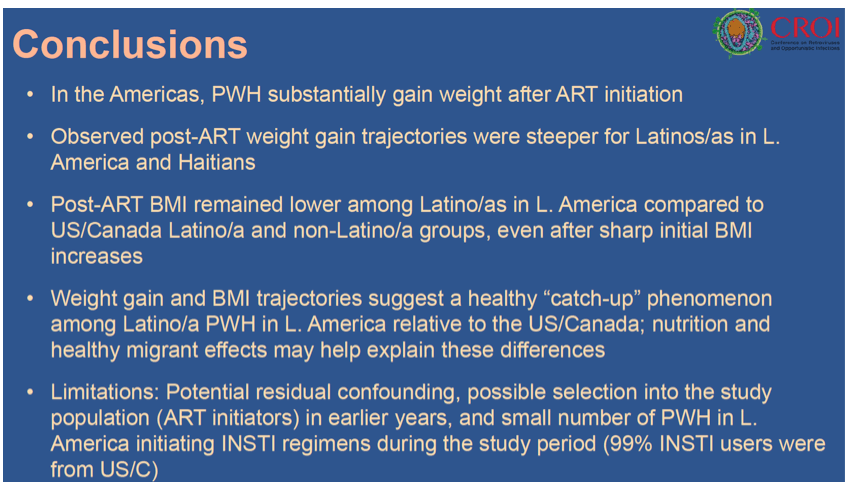
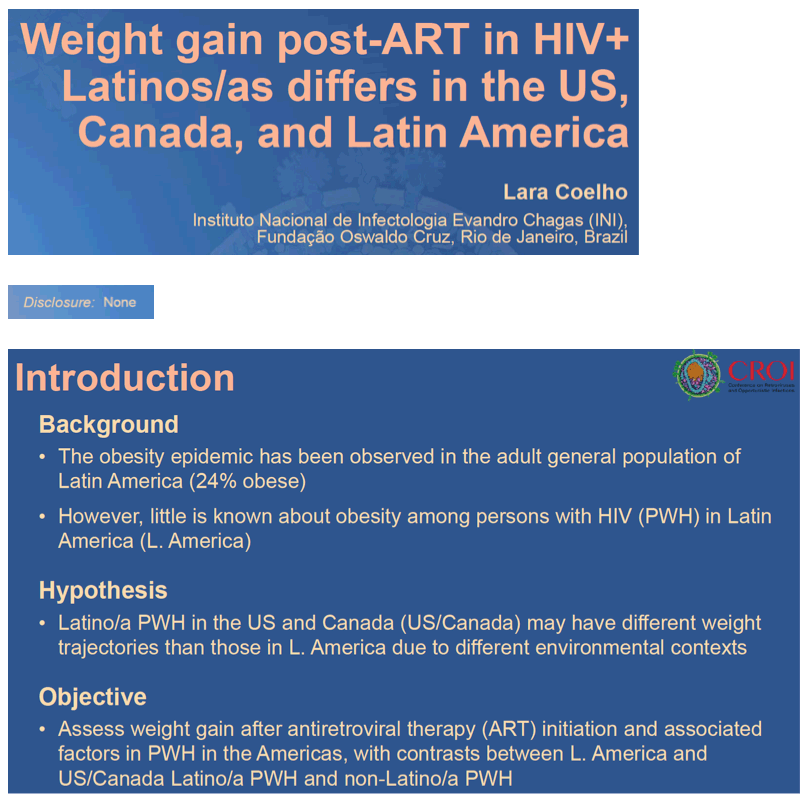
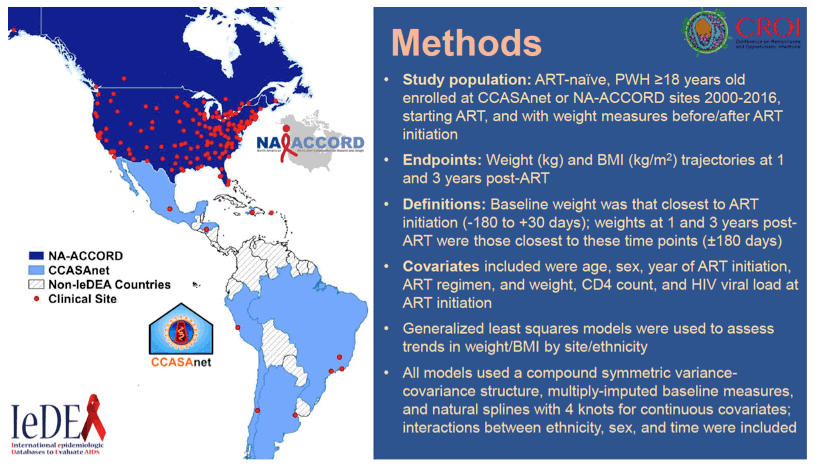
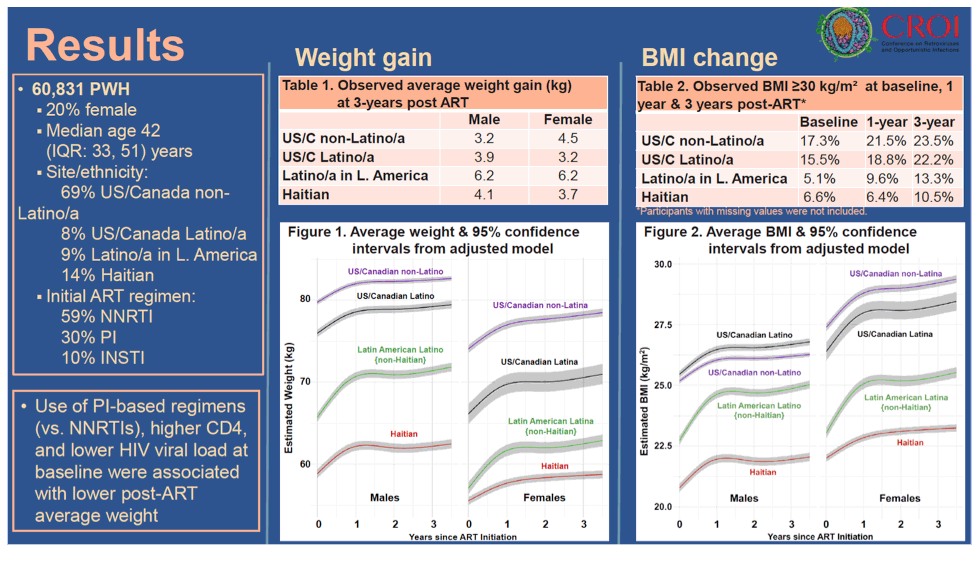
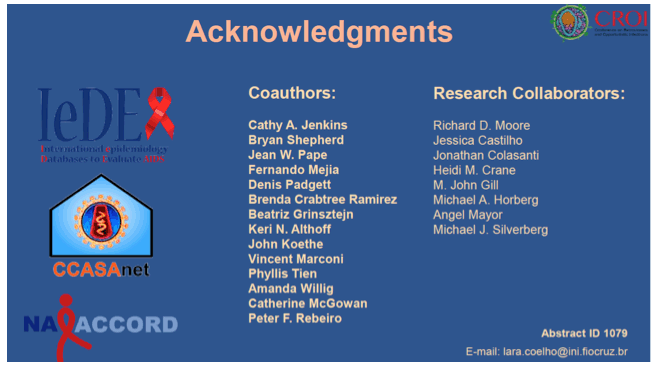
|
| |
|
 |
 |
|
|